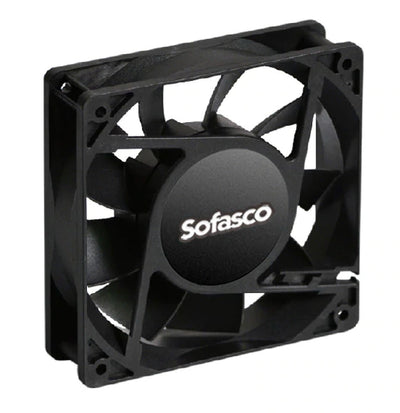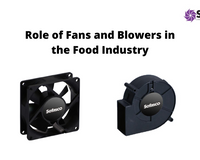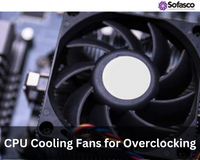Proper PC cooling is critical for ensuring the longevity and optimal performance of your computer components. As modern computers continue to become more powerful, they also generate more heat. This excess heat can lead to various issues, including reduced performance, component damage and even system crashes. Therefore, it's essential to maintain the right operating temperature for your PC. In this comprehensive guide, we will cover a PC temperature management, types of computer case fans and fan placement and configuration.
Understanding Case Fans and Their Functionality
Case fans, also known as computer fans or chassis fans, are vital components in a computer's cooling system. They play a pivotal role in managing temperature and dissipating the heat generated by internal components like the CPU, GPU, PSU, and storage devices. In this blog, we will delve into the concept of case fans, shedding light on their purpose and how they function.
How a Case Fan Operates:
The circulation of air within the computer case or chassis. This circulation is crucial for maintaining an optimal operating temperature and preventing overheating there by ensuring the efficient performance and extended lifespan of internal components. Below, we'll unravel the inner workings of a case fan:
- Air Inflow: Typically situated in specific locations on the computer case, often near the front or sides, the fan springs into action when powered on, initiating the rotation of its blades.
- Air Movement: As the fan's blades spin, they generate a directional airflow. Most case fans are designed to draw external air into the case, introducing a stream of cooler air to the internal components.
- Cooling the Components: This incoming cool air is directed over critical components such as the CPU, GPU, RAM, and storage drives, all of which generate heat during operation.
- Heat Dissipation: As the cool air passes over these heated components, it absorbs some of the generated heat. Simultaneously, another fan, often positioned at the rear or top of the case, expels the now-warm air from inside the case.
- Continuous Cooling Cycle: This continuous cycle of drawing in cooler air and expelling hot air is instrumental in maintaining a stable operating temperature for the internal components. By doing so, it prevents overheating, thus ensuring consistent performance and stability.
- Optimal Airflow Dynamics: Case fans are strategically placed to create efficient airflow patterns within the case. This includes directing air over heat sinks, radiators, and other critical areas that require additional cooling.
What are the Different Types of Case Fans?
- 40 mm Case Fan: These compact fans are commonly used in small form factor (SFF) PCs, embedded systems, and specialized cooling solutions. They are ideal for tight spaces where larger fans cannot fit.

40 MM sD4020 Series DC Axial Fans
Compact and efficient 40x40x20mm DC cooling fans designed for stable airflow and low-noise operation. Available in 5V, 12V, and 24V
- 60 mm Case Fan: 60 mm fans are often used in small PC cases, slim laptops, and some server rack systems. They provide a balance between cooling efficiency and space constraints.

60 MM DC Axial Fans - 12V, 24V, 48v sD8032 Series Fan
High-performance 60x60x20mm DC cooling fans designed for reliable airflow and low noise operation. Available in 12V, 24V, and 48V
- 80 mm Case Fan: 80 mm fans are versatile and can be found in various PC cases, including mid-tower and compact cases. They offer good cooling performance for their size and are commonly used for general-purpose cooling.

80 MM DC Axial Fans - 12V, 24V, 48v sD8032 Series Fan
Powerful and efficient 80x80x32mm DC cooling fans engineered for stable performance and extended lifespan. Available in 12V, 24V, and 48V
- 92 mm Case Fan: These 92 mm fans are suitable for mid-tower and some small form factor cases. They provide improved airflow compared to 80 mm fans and are often used to cool CPUs and GPUs.

92 MM DC Axial Fans - 12V, 24v, 48V sD9238 Series Fan
Durable 92x92x38mm DC cooling fans designed for high airflow and long-lasting performance. Available in 12V, 24V, and 48V
- 120 mm Case Fan: 120 mm fans are the most popular choice for PC cases. They offer a good balance between cooling performance and noise levels. They can be used for both intake and exhaust functions and are often found in gaming PCs and workstations.

120 MM DC Axial Fans - 12V, 24v, 48v sD12032 Series Fan
High-efficiency 120x120x32mm DC cooling fans built for maximum airflow and reliability. Available in 12V, 24V, and 48V
- 140 mm Case Fan: 140 mm fans are larger and quieter than their 120 mm counterparts. They are commonly used in cases that can accommodate their size, providing excellent cooling with reduced noise levels. These fans are favored by PC enthusiasts.

140 MM Case Fan
Large-size 140mm case fan designed for superior airflow and quiet cooling performance. Perfect for desktops, industrial cabinets, and equipment ventilation.
- 200 mm Case Fan: These large fans are typically found in full-tower cases and some specialized cases designed for maximum cooling. They move a substantial volume of air while maintaining lower RPMs, resulting in quieter operation.

200 mm Case Fan sA17251V2H-S
High-performance AC cooling fan with a compact 172x172x51mm design for superior heat dissipation and continuous airflow.
The Role of Case Fans in Maintaining Temperature
Case fans play a pivotal role in maintaining a balanced and efficient cooling system within your PC. They help by:
- Airflow Regulation: Case fans are responsible for circulating air within your computer case, ensuring that cool air enters and warm air is expelled. This prevents the buildup of hot spots and keeps temperature levels within acceptable ranges.
- Component Cooling: Case fans provide direct cooling to components like the CPU, GPU, RAM, and storage drives. Proper airflow keeps these components at their optimal operating temperatures, preventing overheating.
- Dust Management: In addition to cooling, case fans can help manage dust buildup. Some fans come with dust filters that trap particles, reducing the need for frequent internal cleaning and maintaining consistent airflow.
Fan Placement and Configuration
A. The Importance of Fan Placement:
Fan placement within your PC case is critical for maintaining proper airflow and efficient cooling. Proper fan placement ensures that cool air is drawn in and circulated while hot air is expelled, preventing heat buildup and maintaining temperature balance. The strategic placement of fans can significantly impact your PC's overall performance and longevity.
The key reasons why fan placement is important to include:
- Temperature Control: Well-placed fans help manage temperature by directing airflow to critical components such as the CPU and GPU, preventing overheating.
- Dust Management: Proper fan placement can help prevent dust buildup by ensuring that air is drawn in through filters and expelled, minimizing the accumulation of dust on internal components.
- Noise Reduction: Correctly configured fans can help reduce noise by providing efficient cooling, allowing you to maintain a quiet PC environment.
B. Strategies for Optimal Fan Configuration
Intake vs. Exhaust Fans:
- Intake Fans: Intake fans draw cool external air into the case. They are typically positioned at the front or sides of the case. Intake fans are essential for providing fresh air to cool components like the CPU, GPU, and RAM.
- Exhaust Fans: Exhaust fans expel hot air from the case. They are often located at the rear or top of the case. Exhaust fans are crucial for expelling heat generated by components and ensuring hot air doesn't get trapped inside.
Positive vs. Negative Air Pressure:
- Positive Air Pressure: This occurs when you have more intake fans than exhaust fans. Positive pressure helps prevent dust from entering the case because the higher intake fan count results in air being pushed out through unsealed gaps and vents, keeping dust away.
- Negative Air Pressure: Negative pressure is achieved when you have more exhaust fans than intake fans. While it expels heat efficiently, negative pressure can draw in dust through unsealed gaps and vents. Regular cleaning is crucial in negative pressure setups.
C. Ideal Fan Placement for Specific Use Cases
The ideal fan placement varies depending on your PC's purpose and component layout. Here are some recommendations for specific use cases:
- Gaming PC: For gaming PCs with powerful CPUs and GPUs, prioritize intake fans at the front and exhaust fans at the rear and top of the case to ensure efficient cooling. Additional fans on the side panel can help direct airflow to the GPU.
- Workstation: Workstations often have high-end components that generate more heat. Use a combination of intake and exhaust fans to ensure a balanced airflow, and consider placing additional fans near CPU coolers and GPUs.
- Home Server: Home servers should have reliable cooling to ensure 24/7 operation. Maintain a positive air pressure setup to keep dust out, and use exhaust fans strategically to expel heat generated by hard drives and other components.
- Compact Cases: Compact cases have limited space, so choose fans carefully. Opt for low-profile CPU coolers, and consider using slim fans and blower-style GPU coolers to maximize airflow within confined spaces.
To gain all the benefits of computer case fans, one must consider buying high-quality products from reliable suppliers like Sofasco. The company is a global supplier of industrial axial fans, centrifugal fans, cross-flow fans, and blower Fans etc. Since 1981, the company has been supplying high-quality industrial fans for industries like electrical, telecommunication, automotive industry and more. Get in touch with their team to know more about these industrial fans.












